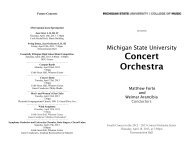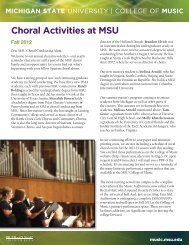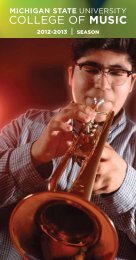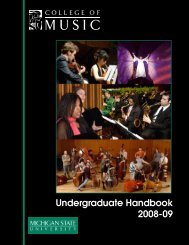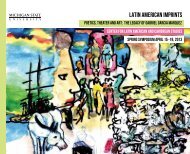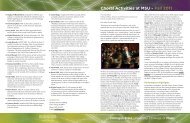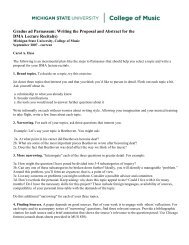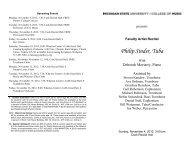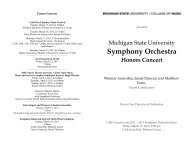DMA Document Proposal Example #2 - MSU College of Music
DMA Document Proposal Example #2 - MSU College of Music
DMA Document Proposal Example #2 - MSU College of Music
You also want an ePaper? Increase the reach of your titles
YUMPU automatically turns print PDFs into web optimized ePapers that Google loves.
1LUTOSŁAWSKI’S FIRST SYMPHONY IN RELATION TO NEOCLASSICISM:<strong>Music</strong>ologists <strong>of</strong>ten point to Witold Lutosławski’s First Symphony (1941-1947) as theconsummation <strong>of</strong> his early period. 1 Many have also labeled the work and the period it embodiesas “neoclassical.” 2 While this term has proven useful as a catch-all in generalized discussions <strong>of</strong>Lutosławski’s music, its use has also created much confusion and even lively debate as to itsexact meaning and limitations. Such is the case with its application to the First Symphony.While a small number <strong>of</strong> writers have addressed the neoclassical label in relation to thesymphony, their references are invariably in passing or serve other analytical agendas. 3 To date,no author has examined the entirety <strong>of</strong> this important work in relation to any clearly definednorms <strong>of</strong> neoclassicism.The development <strong>of</strong> neoclassicism under the influence <strong>of</strong> Stravinsky is thoroughlydetailed by Scott Messing. 4 In his book, he also outlines characteristics that are prevalent inneoclassical works, such as traditional sectional form, independence from programmaticinfluences (opera excluded), free interchange <strong>of</strong> major and minor thirds, and the addition <strong>of</strong>1 This includes Stanis3aw Bedkowski, “Witold Lutosławski (1913-1994),” In <strong>Music</strong> <strong>of</strong> the Twentieth-CenturyAvant-Garde: A Biocritical Sourcebook, edited by Larry Sitsky, 282-90 (Westport, CT: Greenwood Press, 2002),283; Charles Bodman Rae, The <strong>Music</strong> <strong>of</strong> Lutosławski, (London: Faber and Faber Ltd., 1994), 30; Gertruida MariaSteyn, “The Evolution <strong>of</strong> Witold Lutosławski’s Style From 1936 To 1983: A Study <strong>of</strong> Various Stylistic FacetsDisplayed In His Three Symphonies,” Ph.D diss. (University <strong>of</strong> South Africa, 1988), v; and Steven Stucky,Lutosławski and His <strong>Music</strong> (Cambridge: Cambridge University Press, 1981), 129.2 Most notable are Jadwiga Paja (-Stach), “The Polyphonic Aspect <strong>of</strong> Lutosławski’s <strong>Music</strong>,” Acta <strong>Music</strong>ologica 62(1990): 183; and Steyn, “The Evolution <strong>of</strong> Witold Lutosławski’s Style,” 21. The neoclassical label most likelyoriginates in Stefan Jarocinski, “Polish <strong>Music</strong> After World War II,” <strong>Music</strong>al Quarterly 51:1 (1965): 244-58.3 In passing: Arnold Whittall, “Between Polarity and Synthesis: The Modernist Paradigm in Lutosławski’sConcertos for Cello and Piano.” In Lutosławski Studies, edited by Zbigniew Skowron, 244-68 (New York: OxfordUniversity Press, 2001), 258; and Bayley, Amanda, “Past and Present,” review <strong>of</strong> Lutosławski Studies, edited byZbigniew Skowron, The <strong>Music</strong>al Times 144, no.1882 ( 2003): 71. Other analytical agendas: Paja (-Stach), “ThePolyphonic Aspect <strong>of</strong> Lutosławski’s <strong>Music</strong>,” 183. Neoclassicism is also a major component in Jadwiga Paja-Stach,“The Stylistic Traits <strong>of</strong> Lutosławski’s Works for Solo Instrument and Piano.” In Lutosławski Studies, edited byZbigniew Skowron, 269-86 (New York: Oxford University Press, 2001).
2pitches to the diatonic collection. The inextricable bond between neoclassicism and Stravinskyis discussed by Joseph Straus, Eric Salzman and Mosco Carner. 5The most complete analysis <strong>of</strong> the First Symphony is by Gertruida Steyn. 6 She examinesthe work’s construction, cites contemporaneous and current criticism, and discussesneoclassicism as relevant to Lutosławski’s early period. Both Charles Rae and Steven Stuckyanalyze sections <strong>of</strong> the First Symphony, focusing on Lutosławski’s chord structures and use <strong>of</strong>canon. 7 In their respective writings, Rae and Stucky argue against applying “neoclassicism” tothe symphony, each saying that this work is too modern to warrant the label. 8 Stefan Jarocinskiand Arnold Whittall acknowledge the problems the term creates but do not <strong>of</strong>fer any argumentfor or against its use. 9 In a 1974 interview with Bálint Varga, Lutosławski himself speaks <strong>of</strong> thecomposers who influenced his early pieces, though without recourse to “neoclassicism.” 10 Themajor proponent <strong>of</strong> neoclassicism in relation to Lutosławski’s music is Jadwiga Paja-Stach, whocites sections <strong>of</strong> the First Symphony as examples <strong>of</strong> neoclassical counterpoint. 11 In a separatepublication she provides a more detailed description <strong>of</strong> neoclassicism in Lutosławski’s worksbut fails to include the symphony. 12 Lutosławski’s connection with neoclassicism in popularprint is evidenced by John Rockwell’s article for The New York Times. 134 Scott Messing, Neoclassicism in <strong>Music</strong>: From the Genesis <strong>of</strong> the Concept Through the Schoenberg/StravinskyPolemic (Rochester, NY: University <strong>of</strong> Rochester Press, 1996), 106-17.5 Joseph N Straus, Remaking the Past (Cambridge, MA: Harvard University Press, 1990), 1-20; Eric Salzman,Twentieth-Century <strong>Music</strong>: An Introduction (Englewood Cliffs, NJ: Prentice-Hall, Inc., 1967), 45-59; and MoscoCarner, “<strong>Music</strong> in the Mainland <strong>of</strong> Europe: 1918-1939,” In The New Oxford History <strong>of</strong> <strong>Music</strong>, vol. 10, edited byMartin Cooper, 208-10 (London: Oxford University Press, 1974) 217-22.6 Steyn, “The Evolution <strong>of</strong> Witold Lutosławski’s Style,” 1-191.7 Charles Bodman Rae, The <strong>Music</strong> <strong>of</strong> Lutosławski, 25-33; Steven Stucky, Lutosławski and His <strong>Music</strong>, 23-33.8 Rae, The <strong>Music</strong> <strong>of</strong> Lutosławski, 25; Stucky, Lutosławski and His <strong>Music</strong>, 33.9Stefan Jarocinski, “Polish <strong>Music</strong> After World War II,”248; Arnold Whittall, “Between Polarity and Synthesis,”258.10 Bálint András Varga. Lutosławski Pr<strong>of</strong>ile: Witold Lutosławski in Conversation with Bálint Adrás Varga(London: Chester <strong>Music</strong>, 1976), 15-20.11 Jadwiga Paja, “The Polyphonic Aspect <strong>of</strong> Lutosławski’s <strong>Music</strong>.12 Jadwiga Paja-Stach, “The Stylistic Traits <strong>of</strong> Lutosławski’s Works,” 269-74.13John Rockwell, “Appreciating a European Avant-Gardist,” New York Times, March 18, 1979, D29.
3This document explores the tenuous link between Lutosławski’s First Symphony andneoclassicism. Using the traits set forth by Messing, I will provide a theoretical justification forlabeling the First Symphony neoclassical. I will employ Stravinsky’s Symphony in C todemonstrate the neoclassical paradigm. Through comparisons with Stravinsky’s Petrouchka andThe Firebird I will also argue that as it applies to the First Symphony, neoclassicism has beenbroadened to simply mean, “bearing the influence <strong>of</strong> Stravinsky.”Chapter 1, “Introduction,” sets forth the issue <strong>of</strong> neoclassicism in relation to the FirstSymphony, and includes the label’s proponents and detractors. Chapter 2, “A History,” is ahistory <strong>of</strong> Lutosławski and the First Symphony. Chapter 3, “Neoclassicism,” presentsMessing’s neoclassical traits and includes examples from widely acknowledged neoclassicalworks. Chapter 4, “The First Symphony and Neoclassicism,” analyzes the symphony and relatesit to the traits discussed in chapter 3. In this chapter, aspects <strong>of</strong> the symphony will also becompared to sections <strong>of</strong> Stravinsky’s Russian-period Petrouchka and The Firebird, as well as theneoclassical Symphony in C. Here, I will argue that while the term neoclassical is permissible, itmust be applied with acknowledgment <strong>of</strong> its broader meaning. Chapter 5 will serve as thedocument’s conclusion.
4BIBLIOGRAPHYBayley, Amanda. “Past and Present.” review <strong>of</strong> Lutosławski Studies, edited by ZbigniewSkowron. The <strong>Music</strong>al Times 144, no.1882 ( 2003): 71-72.Bedkowski, Stanisław. “Witold Lutosławski (1913-1994).” In <strong>Music</strong> <strong>of</strong> the Twentieth-CenturyAvant-Garde: A Biocritical Sourcebook, edited by Larry Sitsky, 282-90. Westport, CT:Greenwood Press, 2002.Booker, Mary. <strong>Music</strong> in the Twentieth Century. Devon: Arthur H. Stockwell Ltd., 1980.Carner, Mosco. “<strong>Music</strong> in the Mainland <strong>of</strong> Europe: 1918-1939.” In The New Oxford History <strong>of</strong><strong>Music</strong>, vol. 10, edited by Martin Cooper, 208-10. London: Oxford University Press, 1974.Danuser, Hermann. “Rewriting the past: classicisms <strong>of</strong> the inter-war period.” In The CambridgeHistory <strong>of</strong> Twentieth-Century <strong>Music</strong>, edited by Nicholas Cook and Anthony Pople, 260-85.Cambridge: Cambridge University Press, 2004.Erhardt, Ludwik. <strong>Music</strong> in Poland. Warsaw: Interpress Publishers, 1975.Ford, Christopher. “Lutosławski’s First.” <strong>Music</strong> and <strong>Music</strong>ians 25, no.297 (1977): 4-5.Jarocinski, Stefan. “Polish <strong>Music</strong> After World War II.” <strong>Music</strong>al Quarterly 51:1 (1965): 244-58.Kaczynski, Tadeusz. Conversations with Witold Lutosławski. Translated by Yolanta May.London: Chester <strong>Music</strong>, 1984.Lee, Douglas. Masterworks <strong>of</strong> 20 th -Century <strong>Music</strong>. New York: Routledge, 2002.Maciejewski, B.M. Twelve Polish Composers. London: Allegro Press, 1976.Messing, Scott. Neoclassicism in <strong>Music</strong>: From the Genesis <strong>of</strong> the Concept Through theSchoenberg/Stravinsky Polemic. Rochester, NY: University <strong>of</strong> Rochester Press, 1996.Paja, Jadwiga (-Stach). “The Polyphonic Aspect <strong>of</strong> Lutosławski’s <strong>Music</strong>.” Acta <strong>Music</strong>ologica62 (1990): 183-91.___. “The Stylistic Traits <strong>of</strong> Lutosławski’s Works for Solo Instrument and Piano.” InLutosławski Studies, edited by Zbigniew Skowron, 269-86. New York: Oxford University Press,2001.Rae, Charles Bodman. The <strong>Music</strong> <strong>of</strong> Lutosławski. London: Faber and Faber Ltd., 1994.Rockwell, John. “Appreciating a European Avant-Gardist.” New York Times, March 18, 1979,D29.
5Salzman, Eric. Twentieth-Century <strong>Music</strong>: An Introduction. Englewood Cliffs, NJ: Prentice-Hall,Inc., 1967.Steyn, Gertruida Maria. “The Evolution <strong>of</strong> Witold Lutosławski’s Style From 1936 To 1983: AStudy <strong>of</strong> Various Stylistic Facets Displayed In His Three Symphonies.” PhD diss., University <strong>of</strong>South Africa, 1988.Straus, Joseph N. Remaking the Past. Cambridge, MA: Harvard University Press, 1990.Stucky, Steven. Lutosławski and His <strong>Music</strong>. Cambridge: Cambridge University Press, 1981.___. “Change and Constancy: The Essential Lutosławski.” In Lutosławski Studies, edited byZbigniew Skowron, 127-62. New York: Oxford University Press, 2001.Varga, Bálint András. Lutosławski Pr<strong>of</strong>ile: Witold Lutosławski in Conversation with BálintAdrás Varga. London: Chester <strong>Music</strong>, 1976.Whittall, Arnold. “Between Polarity and Synthesis: The Modernist Paradigm in Lutosławski’sConcertos for Cello and Piano.” In Lutosławski Studies, edited by Zbigniew Skowron, 244-68.New York: Oxford University Press, 2001.


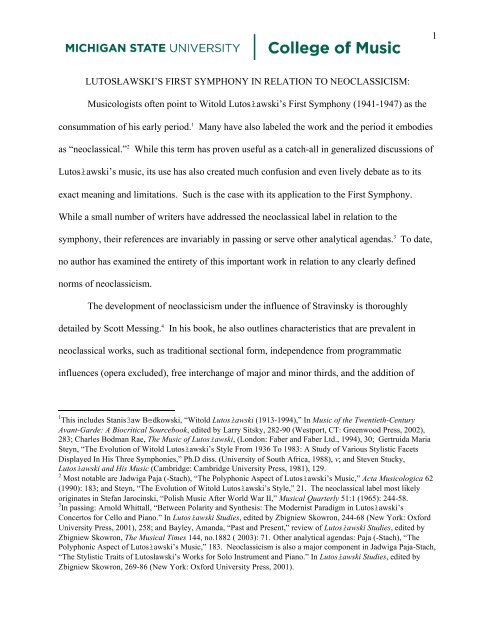

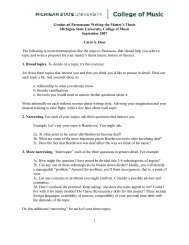
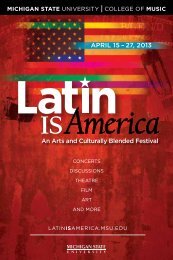
![evaluation form [PDF] - MSU College of Music - Michigan State ...](https://img.yumpu.com/48155330/1/190x245/evaluation-form-pdf-msu-college-of-music-michigan-state-.jpg?quality=85)
